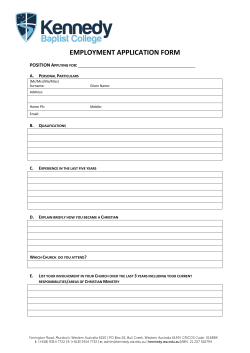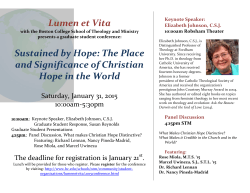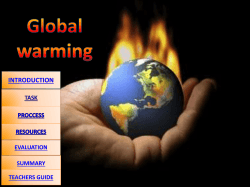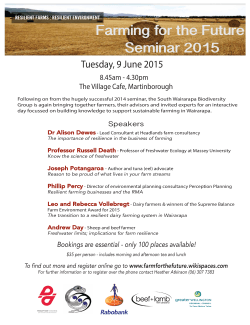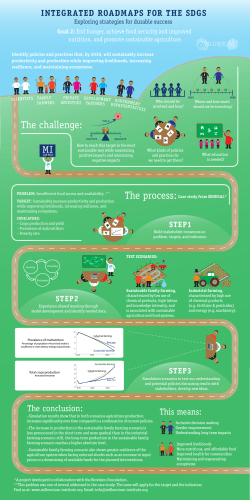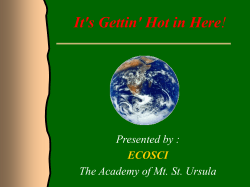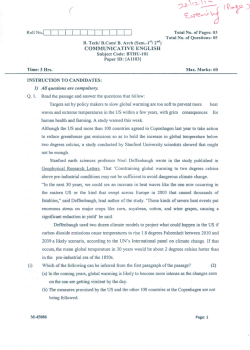
Read more⦠- Honey & Thistles
GLOBAL CLIMATE CHANGE : AGRICULTURAL IMPLICATIONS & THEOLOGICAL REFLECTIONS Rural Theology 6(2), 75-89, Issue 71, 2008. by John Wibberley1 Professor John Wibberley, Royal Agricultural College, Cirencester Address for correspondence:Springvale, , Orchard Close, Shaldon, Devon TQ14 0HF, England [email protected] 1 Dr John Wibberley NSch, FRAgS is a Professor of Agriculture & Resource Management Consultant working internationally. John serves in RURCON, an otherwise all-African team of Christian development leaders providing Service for Wholistic Development through Christian Churches in Africa’ (HQ Nigeria). He also works with ATP (Agriculture & Theology Project of the Agricultural Christian Fellowship & Church Mission Society). ABSTRACT The case for global climate change is made, with reference to current warming trends and consequent increases in the severity and unpredictability of the weather. Consensus is considerable that substantial contribution is made to it by human activity. Agriculture, including livestock production in particular, contributes its share to global warming. Agricultural implications may include suffering or gain from climate change depending upon where one is farming. In general, already marginal, food insecure areas will suffer most – notably in subSaharan Africa. Moral dilemmas are raised not only by the events resulting and likely to result from climate change but also from the actual and potential responses to it at both policy and personal levels. Practical responses to these realities are considered in the light of some basic theological reflections. The case for Climate Change: dimensions of global warming GREENHOUSE GASES (GHGs): The direct cause of global warming is accumulation of ‘greenhouse gases’ (GHGs) notably CO² , though many others while less abundant are much more toxic per molecule e.g. methane and other hydrocarbons, and nitrous oxide, which must be mitigated (DeAngelo et al, 2006). Burning of fossil fuels accounts for 75% of historic CO² emissions. CO² levels reached 381 ppm in 2005, 40% up since the industrial revolution; other GHGs (such as methane, nitrous oxide, halocarbons) increased at similar rates. Global mean surface temperatures rose by 0.6ºC during the 20th century. During the 21st century, global surface temperature is projected by the Hadley Centre Model to rise by 1.4-5.8 ºC with more droughts, more floods and more severe tropical cyclones (Burke, Brown & Christidis, 2006). The ramifications of this climate change are clearly explored by Maslin (2004). Global warming is perhaps the biggest challenge facing the world, and we must treat the earth as an interdependent whole living system (Lovelock, 2006). Sir John Houghton FRS and the IPCC (International Panel on Climate Change) chart the facts of climate change (Houghton, 2004; IPCC, 2007a); it is now reckoned by the IPCC that global temperatures will rise by between 1.1°C and 6.4°C by the year 2100. For Sierra Leone, for example, the rise will probably be 3.0-3.5°C. In Kenya, a 2°C rise would lead to loss of much of the coffee and tea-growing potential of the Aberdares and Mount Kenya slopes; Mount Kenya has already lost over 80% of its snow and ice cap and the whole country is set to become a water deficit nation within 5 years (Sunday Nation, Nairobi 12.8.’07, p.5). SEA CHANGES: Sea levels will rise by between 18 and 59cm, with Arctic summer sea ice disappearing during the second half of this century (IPCC, 2007a) with huge consequences for coastal livelihoods, including agriculture. Since heat in the oceans drives the world’s climate systems, there may be radical changes – even, it has been suggested, a reversal of the Atlantic ocean currents which bring warmer waters to Europe from West Africa thus drawing cold currents down from the Arctic. SEVERE WEATHER: More extreme weather is set to persist, with winds more violent, changing weather patterns more dramatically with increased heatwaves and more intense tropical storms. Harsher droughts in the tropics and bigger cyclones have occurred since the 1970s (Emanuel, 2005), as well as accelerated melting of polar ice sheets and retreat of glaciers. Rainfall belts are moving further northwards and southwards from regions like the Sahel and within southern Africa, making droughts more likely (as warned by Timberlake, 1986). Yet three major energy users and thus emitters - USA, China and India - have still not signed the Kyoto protocols agreeing to pursue policies to limit their global warming impacts; however, California agreed to sign in 2006. It is hoped that the protocol agreed by all countries, including the USA, at the December 2007 UN Summit on Climate Change in Bali, Indonesia will lead to significant political change implemented globally in 2009. Former US Vice-President Al Gore has written a book and made a powerfully influential film about the ‘inconvenient truth’ of climate change (Gore, 2006) since the USA is responsible for 25% of global CO² emissions and 52% of US energy comes from coal. A significant amount of this is derived by ‘Mountain topping’ (simply shaving off mountains to enable open-cast extraction of the coal, as in West Virginia). However, some still contest the overwhelming consensus of scientists that global warming is significantly human induced. REGIONAL VARIATIONS: Though India is 4th in the league table of CO² emitters, it has only 25% of the world average per capita CO² emission, thus some argue that India – and China, and Africa too – should be allowed to ‘catch up’ with the industrialised nations and become equally carbon harmful. The World Bank (2005) estimated that average global CO² emissions were 12.4 tonnes CO² per person per annum, ranging from USA = 19.8 to China = 2.2, to poorest countries = 0.8). Smith (2006) reports that during the past 250 years, Africa is reckoned to have emitted only one-tenth of the CO² by contrast with Western Europe. However, Africa is damaged in other ways by its current and growing contribution to global warming from deforestation for cooking fuel – often used on flue-less fires between three stones with huge energy-inefficiency (typically using some 2.5 times the wood needed in fuel-efficient stoves) consequently damaging the environment, impairing soil and water conservation, wasting time in wood collection, and depleting family budgets and the health of cooks. POLICY & PEOPLE: The 1997 Kyoto meetings proposed trading in ‘emission quotas’ whereby a country might offset its own warming impact by buying quotas from a country emitting less (typically a ‘developing’ country also greatly in need of the funds so generated). Likewise, those travelling by air or using high levels of fossil fuels in other ways can offset their ‘carbon footprint’ by planting trees to absorb the equivalent amount of CO² (Lynas, 2007). Climate has changed before. For example, in 1622 ‘all the rivers in Europe froze over’ (Baker, 1883) while, on the other hand, there were vines grown in England during the 11th Century. However, even though warming may be occurring on a long-term cycle beyond human damage alone, it is hard to deny that human impacts are contributing to it more than ever in history. The past 50 years have warmed twice as fast as the previous 50 years in the UK. Implications of climate change for Agriculture Greater poverty impacts agriculture hugely since it hampers human energy/effort to plant and restricts capacity to afford necessary inputs. Smith (2006) notes that over 40% of the world’s people are unable or barely able to meet their needs for survival. Climate change threatens to make the Millennium Development Goals unattainable. It will result in greater poverty, wider discrepancy between rich and poor, sea level rises, and more precarious livelihoods challenging survival. Already, 2.7 billion people try to live on £1 or less per day. Smith (2006) argues that action on climate change is integral to poverty reduction. Such action requires both mitigation of the rate of change (Keller et al, 2005) and adaptation to that which does occur. Stabilising CO² at 450 ppm (requiring cuts of 60-90% in GHG emissions before 2100) may limit the mean global temperature rise to 2ºC. Mitigation of climate change is affordable; to stabilise at 450 ppm CO² would cost 1-4% of global average GDP over 50 years. Kyoto protocol implementation would cost 0.1% of GDP over 10 years. Justice and equity demand that action is taken. Climate change has important implications for food production, processing and distribution and thus for food security. Agriculture contributes towards climate change as well as both suffering from it and potentially in some areas benefiting from it (Spedding, 2007). Farming people are calculating their carbon footprints, in order not only to mitigate them but also to make business sense of their impacts (Nuffield, 2008). According to Stern (2006) global ‘greenhouse gas’ (GHG) emissions arise from the major sources listed as follows:- Power stations 24%; Land misuse – mainly deforestation -18% (Brazil leads on this = 3.1Mha between 2000-2005, followed by Indonesia = 1.8 Mha); Transport, including aviation 14%; Agriculture 14%; Industry 14%; Fuel used in buildings 8%. LIVESTOCK: Livestock production contributes almost 80% of agriculture’s total GHG emissions. This arises from deforestation to create pastures, emissions from livestock manures especially of nitrous oxide, and methane originating from rumen fermentation (25% of it from dairy cows). However, mitigation consists in keeping livestock in integrated mixed farming systems. As people become wealthier, they tend to consume more dairy products and meat, especially red meat (from ruminants). McMichael, Powles, Butler and Uauy (2007) recommend policy attention to this on health grounds, notably its tendency to increase ischaemic heart disease, obesity and colo-rectal cancer. McMichael et al (2007) note that current global daily consumption of all meats averages some 100g per person though this varies by ten-fold between the lowest and highest consumption figures (e.g. Africa 31g; ‘developed’ countries 224g). They suggest a daily target of 90g per person maximum, with not more than 50g as red meat. Apart from health gains, eating more chicken and vegetarian-farmed fish would reduce agriculture’s output of methane and protect wild fish stocks. Eating more crop products is more efficient in delivering overall dietary supplies, bearing in mind that currently over 850 million people – around one person in eight - still go to bed hungry each night. This figure could reduce to 300 million by 2080, according to Fischer, Shah, Tubiello and van Veldhuizen (2005) but they reckon that between 1 and 3 billion people in poor and food-insecure countries could face losses of 10-20% of their cereal production owing to climate change. THE FOOD CHAIN: In the UK, Box, Wakeman and Smith (2005) reckon food imports consume 1.6 billion litres of fuel and generate 4.1 million tonnes of CO² emissions. For every calorie of energy used for growing food, five more are used in processing, storage and distribution. One-sixth of all UK energy use is consumed within the food system. For London, 41% of the ecological footprint is due to the food system, notably excessive food miles and waste of food in catering outlets (LDA, 2005; see also BFF, 2000). However, the UK Farmers Weekly ran a well-publicised campaign in 2006/07 ‘Local Food is Miles Better’ taking up the established ‘food miles’ concept of Prof. Tim Lang (e.g. Lang & Heasman, 2004). Oil is getting scarce; airfreight uses some 60 times the energy of sea transport and trucks use some 10 times the energy of trains per tonne carried, while boxed, processed cereals such as Corn Flakes contain less than one-sixth of the energy it takes to produce them. Wibberley (2005) contrasts the typical tropical grower of maize who roasts her own cobs locally, especially if – relatively unusually – she uses a fuel-saving stove; yet feeding the average American takes around 1800 litres of oil equivalent per year. Principal usage of energy within North American agronomy is reckoned as:- 33% fertilisers; 20% machinery operation; 16% transport; 13% irrigation; 5% biocides. Each tonne of the world’s commonest straight nitrogen fertiliser (AN, ammonium nitrate) requires some five tonnes of oil to produce. Some 10% of US national energy use is within agriculture. A global move to sustainable agriculture for sustainable development is clearly vital (Munasinghe & Swart, 2005). International policy targets are for GHG emissions from agriculture by 2050 to be no more than those for 2005. UK Agriculture is likely to experience warmer summers, milder wetter winters, more unpredictable and violent weather events and rising sea levels (HGCA, 2008). Overall, the growing season will be extended boosting arable and forage crop biomass but also allowing greater scrub development, especially in the south-west uplands of England unless grazing pressures are maintained. These uplands are also newly appreciated for their carbon-storing role within their peat reserves! However, warmer conditions also mean scope for previously unknown or unimportant pests and diseases to thrive (including bluetongue and its vectors in cattle and sheep, and potentially African Horse sickness). On the other hand, the UK is becoming better placed to grow vines, olives and other crops more traditionally suited to Mediterranean climates. Australia is suffering more droughts such as that which decimated the cereal harvest from the 2006 crop, contributing to dramatic world grain price rises and their global impacts on agriculture and beyond. Practical responses are particularly urgent for Africa. The Africa Commission (Anon., 2005) proposed debt cancellation, action on global climate change and then, a trading ‘free-for-all’! This last point is unsustainable for farming. Mortimore and Manvell (2006) assert – based on an analysis of 105 DFID-funded Renewable Natural Resources Research Strategy projects - that climate change threatens the livelihoods (including Food Security) of many poor people. Helping poor people to adapt (through research on adaptive crop cultivars, appropriate technologies, strategies and institutions) is imperative, they argue. Current and probable impending detrimental effects on poverty and injustice led Smith (2006) to propose a comprehensive range of practical strategies for mitigation and adaptation, with particular reference to the precarious position of many developing countries. Rainfed agricultural output in some African countries could drop by as much as 50% by 2020 (IPCC, 2007b). For instance, Niger - over five times the size of the UK - already has 80% of its total area as desert and only 3% is cultivable. Millet yields have declined to some 90% of those attained 50 years ago while average sorghum yields are now only 20% of those achieved half a century ago. The 600mm per annum isohyet is receding towards the southern border with Nigeria, further limiting cultivable land. Hope placed in irrigation for rice and vegetables has to be tempered by concerns for careful management regarding the potential speed of salinisation. Countries at comparable latitudes south of the equator in Africa are likely to suffer similarly increased constraints. Niger’s current population of 12 million is projected to rise above 20 million by 2020 and to between 43 and 77 million by 2050, depending on the success or otherwise of birth control measures adopted (Guengant and Banoin, 2003). According to culture, many of the extra people will wish to keep more cattle, goats and sheep. However, albeit under much more favourable rainfall conditions, Send-A-Cow in Uganda (www.sendacow.org.uk) has recently done studies showing huge positive impacts of a single cow or dairy goat on Farm-Household System vitality and viability – and in such integrated systems that the carbon-footprint (notably methane + manure) is offset by recycling, by fodder crops and by tree planting so that over 5 years it is 2.5 times positive! Alongside fuel-efficient moulded mud stoves, more tree planting is also needed, as widely advocated and implemented in Kenya and elsewhere (Maathai, 2007). Smith (2006) offers a framework for action, with particular reference to the precarious position of many developing countries. Theological Reflections: Climate in Biblical context Climate, the long-term trend of the weather, is symbolised by the state of the sky above – ‘the heavens’ – to be celebrated as well as heeded as a source of warnings. Psalm 8:3 records, ‘When I consider Your heavens…’ The Cloud Appreciation Society (Pretor-Pinney, 2006) celebrates the beauty and diversity of clouds and invites their study as objects of wonder. The Bible reminds us that ‘The heavens declare the glory of God and the skies proclaim the work of His hands. Day after day they pour forth speech; night after night they display knowledge. There is no speech or language where their voice is not heard’ (Psa.19:1-3). Psalm 148 exhorts celebration of the linkage between the heavens and earth, and the interconnection of all creation designed to the praise of God. However, failure of faithfulness and love towards God in not following His ways is the cause of the land mourning, says Hosea (4:1-3) ‘…the birds of the air and the fish of the sea are dying’. Yet insurance policies speak of ‘acts of God’ to describe catastrophes or accidents beyond human control. Given Biblical theology that espouses a Sovereign, Benevolent, Omniscient, Omnipresent and Omnipotent God, it is easy to expect that somehow He will over-rule our impacts on climate change, of which we assume Him to be in ultimate control. This brings in theodicy: how does a good, all-powerful God come to allow the suffering consequent upon some climate change features? Well, He also is Judge of the whole earth (Who will, said Abraham by faith – Gen.18:25 – ‘do right’). Doing right involves God dealing with our sin, transgression and iniquity. Ultimately, doing right will involve the return of Jesus Christ to earth to restore all things as at the beginning, to which there are some 300 references/allusions in the Bible. Some of these include eschatological signs involving climate change (e.g. Rev.6:12-14; Luke 21:11, 25-27). Jesus challenged His listeners to interpret the signs of the times as they do weather indicators in the sky (Matt.16:2,3). Already the biological consequences of global climate change are considerable (Beeley, Colwell & Stevens, 2005). Christians in the UK and internationally are becoming more active. A notable initiative is the Climate Stewards campaign of A Rocha: Christians in Conservation (see also Harris, 2008) to help people to reverse their carbon damage (www.climatestewards.co.uk). In the USA, the NAE (National Association of Evangelicals) is belatedly becoming active, but many Christians appear yet immune to reality and some are sceptical about it. Some are in denial that there is anything for us humans to address in regard to climate change; extreme climatic and weather events are ‘acts of God’ they argue e.g. in 1703 Baker (1883) records that 8,000 people lost their lives in floods of the Severn and Thames and on the coast of Holland. Others say, ‘why bother about climate change, my Bible tells me we are getting a new heaven and a new earth – so don’t fuss over this one!’ To such, it is here argued that the Bible teaches care for this earth as stewards now, leaving its ultimate future to God. Jones (2003) offers both a theological basis for such care and practical means to effect it at personal and household levels as well as more widely. Spencer & White (2007) also provide an authoritative, scientifically and theologically grounded account, which covers sociological and economic consequences as well as wider environmental impacts of climate change. They present a profound challenge to current lifestyles with excessive and overt consumption, and make a renewed call to live more simply. They also give, in the last analysis, a hopeful message – rooted in the grace and eternal Kingdom purposes of Almighty God as envisioned in Isaiah chapters 40-66. It is interesting to note that Isaiah’s contemporary and friend, King Hezekiah, constructed a conduit for fresh water under the walls of Jerusalem which is still extant – symbolic of realised vision and a practical reminder of the absolute basic for sustainable living; ‘without vision, the people perish’ (Proverbs 29:18). As the core of our practical reaction to life, the Bible proposes not only kingdom vision but also faith in the God of the Universe now, and acting justly (Micah 6:8). Evans et al (2003) expound that God is the Creator and Sustainer of the Universe (Gen1:1) and was the First Farmer (Gen.2:8). How then does God propose that we relate to His creation? Five ways are suggested in Fig.1 (Wibberley, 2001; Gorringe & Wibberley, 2002). Fig. 1. OUR RELATIONSHIP TO EARTH & ITS CREATURES 1. Dominion = ‘complete authority’ - to do what God likes with creation, not to dominate it! (Gen. 1:26-28). 2. Priesthood = the role to let creation express itself in praise to God (Psalm 150:6) and to offer it to God with praise. 3. Companionship = respectful, caring relationship with creatures (Prov. 12:10). 4. Stewardship = accountable, caring management of resources (Luke 16:2). 5. Teamwork = co-workership in team effort, with God (1 Cor.3:9). The ‘world Christian’ perspective theologically expounded by Winter & Hawthorne (1981) provides a basis for relating appropriately to the cosmos and the Creator on the scale required to address climate change. Fergusson (1998) concludes his theology of the cosmos thus:- ‘Hope for creation is inseparably linked to hope in God the Maker of heaven and earth, in Jesus Christ the incarnate Word and in the Holy Spirit of life and love’ (p.97). In articulating this hope, Spencer and White (2007) outline the kingdom vision of Isaiah chapters 40-66, drawing lessons for sustainable living from it. The Old Testament sets out the principle of repentance before blessing from God, and teaches that this blessing has communal and creation-wide application:- ‘If my people, who are called by my Name, will humble themselves and pray and seek my face and turn from their wicked ways, then will I hear from heaven and will forgive their sin and will heal their land’ (2 Chron.7:14). Berry (2007) presents a Christian framework for environmental sustainability which flows from this principle. The Lord’s Prayer exhorts us to pray and work so that ‘Thy Kingdom come, Thy will be done on earth as it is in heaven’ (Matt 6:10). Discussion: some moral dilemmas 1. Developing countries still wish to grow their economies, including ‘agricultural modernisation’ by the same energy-consuming means as have been used by the already industrialised world. Curtailing their consequent carbon footprints entails depriving them of ‘development’ opportunities already taken by industrialised countries (Tearfund, 2007). 2. Lovelock (2006) concludes that the only realistic way to deliver enough world energy without exacerbating climate change further is to move more to nuclear power sources despite their long-term though low-volume toxic waste problems and other security issues. 3. In order to gain more renewable energy, a large-scale quick-fix solution could be to switch land from food crop to biofuel crop cultivation (Somerville, 2006). This would fuel wealthy motorists and the industrialised sectors of the world economy while depriving especially the poor of food, or at least increasing the price of that available to them. There is the added dilemma that some proposed crops with high potential ethanol yields are also staple food crops – such as cassava (manioc) Africa’s food security crop, a staple for at least 200 million in that continent. In West Africa and in SE Asia, oil palm plantations for fuel are displacing tropical rainforests. 4. Carbon trading would allow richer countries or regions to continue behaving profligately with energy use while providing poorer countries or regions with much-needed funds for their lower emission shares – nevertheless deterring them from ‘development’ and possibly exacerbating income distribution issues to the poor within those countries. 5. FAO (2006) estimates that some 1.3 billion people depend on livestock for their livelihoods. In order to curtail methane and nitrous oxide emissions from large herds/flocks and intensive feedlots, simplistic blacklisting of ruminants as producers of GHGs would deprive the many smallholders who integrate them sustainably within their farming systems of a linch-pin of those systems. It would also deny legitimate production to well-managed extensive systems – such as found in much of upland Britain, and among pastoralists in Africa and elsewhere. 6. Climate change offers not only opportunities to all – more to some than others, but also threats to all – more to some than others. How can the opportunities/benefits be equitably shared? How can the threats be diminished/managed, including special help to those most adversely affected? One example of interconnectedness is the dramatic rise in Christmas tree prices for 2007, 30% up on 2006 (Williamson, 2007). In Germany, one reason for limited supplies was abnormally severe storms, another the switch of land to maize cultivation for biofuel in response to climate change policy signals (see King, 2006), and a third the rise in Christmas tree exports by air in freezer containers to desert locations, such as Dubai! Solutions to these dilemmas must surely start with a revisitation of values and a concerted drive towards sustainability worldwide using incentives to adopt cleaner, leaner energy usage and equitable management of food security? Carbon trading may offer useful short-term help to developing countries, especially if the funds so derived are used to improve the sustainability of their environmental management. The agri-environment is now the focus of integrated study (Warren et al, 2008). The sustainability of farming systems depends on their energy-efficiency; this is the index of efficiency that is applicable worldwide, independent of time and location. Sustainable farming typically integrates livestock and cropping enterprises to the mutual benefit of both. There will have to be better preparation for disasters associated with the more severe weather events now occurring and predicted to increase as characteristics of climate change; this will involve improved disaster risk reduction strategies as well as enhanced disaster response management. Above all, it will require prayer and reliance on God (‘act justly, love mercy and walk humbly with God’ Micah 6:8; this is the motto of the international Christian relief & development Micah Network - see www.micahnetwork.org and Hoek & Thacker, 2008). Conclusions and Future Prospects Global climate change as influenced by human activities is principally about energy imbalances, most notably the natural balance between photosynthetic capture of CO² and the respiratory plus decompositional release of it, together with encumbered recycling of other naturally widespread gases, especially methane and nitrous oxide (both of which accrue significantly from agriculture). As far as agriculture is concerned, sustainability consists in having adequately integrated farming systems that avoid undue concentrations of particular species of animal or crop such that the by-products of each become the inputs for the other. It is high time to place energy efficiency as the central index for measuring the sustainability of such farming systems, as proposed for cereal-based systems (Wibberley, 1989, p.214ff.) and for grassland systems – including the use of artificial intelligence to monitor and analyse relevant parameters (Scholefield, 2007). Horton (2007) considers that :‘energy is a critical, yet hugely neglected determinant of human health... Society suffers from a disordered global energy metabolism … 2 billion people currently lack access to clean energy: they live in energy poverty and insecurity… Energy access and energy equity should become a human development goal … Each of us must consider ourselves as energy agents, as well as energy recipients … Energy insecurity is a foreign policy issue; it is a source of international tension and conflict’. Climate change is bringing many negative impacts. Increasing drought in sub-Saharan Africa is likely to have some of the greatest of such negative impacts, including increased incidence of locust plagues, aphids and whiteflies (IPCC, 2007b). As a global strategy, contraction and convergence of economies is needed, not simply ‘motoring on for growth regardless’ (Meyer, 2000). Efforts regarding climate change relate particularly to pursuing substantial progress by 2015 towards Millennium Development Goal (MDG) 7 to ‘Ensure Environmental Sustainability’, strongly linked to Goal 1 ‘Eradicate Extreme Poverty and Hunger’. Both require Millennium Development Goal 8 – ‘Develop a Global Partnership for Development’. Clearly, all MDGs would be more attainable if population growth was slower. The theological imperative within God’s coherent creation in our shared earth environment calls us to ‘look not everyone to their own things [concerns] but everyone also to the things [concerning] others’ (Phil.2:4). God is passionately concerned about injustice, unforgiveness and arrogance (Micah 6:8). The exhortation of the Lord’s Prayer ‘Thy Kingdom come on earth as it is in heaven’ (Matt.6:10) invites our active engagement now in the tasks needed for more sustainable living as servants who ‘occupy until the Lord returns’ (Luke 19:13) so that meanwhile we manage for creatures and habitats in such a way as to ‘let everything that has breath praise the Lord’ (Psa.150:6a). Practical suggestions towards ameliorating climate change are offered in Fig.2. Bookless (2008) challenges readers to make a local practical response. Fig.2. Climate change checklist for local action at individual, household & community level 1. UNDERSTANDING : realities, trends, targets, issues, opportunities, need to act 2. THEOLOGY : God’s Earthcare & Sovereignty; Psa.8:3,4; Psa.19; Psa.24:1; Luke 8:22-25… 3. LIGHTS : switch off; fit energy-saving bulbs; extinguish ‘sleep’ buttons on TV etc. 4. HEATING & INSULATION : set radiators lower; insulate loft; seal against draughts 5. VENTILATION TO COOL/DRY: regulate natural airflows & use kitchen to dry clothes 6. CLOTHING : adjust wear for heat/cold – e.g. use blankets and sweaters in cold 7. WATER: half-fill kettles; stop leaks; shower not bath; wash up by hand; drink tapwater; use tooth-water sparingly; catch roof-water for gardens; keep washing water for plants. 8. COOKING : eat more raw fruit/vegetables; drink ‘smoothies’; use fuel-efficient stoves 9. PLANTING : plant trees; conserve green spaces; use all you cut; save paper (copy both sides) 10. TRANSPORT & TRAVEL: walk; cycle; fuel-efficient (made & run) cars; holiday nearby 11. FOOD: eat locally-sourced food; ask ‘food miles’/source when buying; solar-dry surpluses 12. RECYCLING: separate green-waste to compost; re-use bottles/jars; use newspaper for fuel This paper suggests that climate change be perceived as connected to God’s redemptive remedy and restorative agenda for earth and humanity. His transcendance beyond climate change is the key to the Christian hope. Rather than panic, our repentance and seeking of His ways is the key to our concerted response to climate change and to our part in causing it . Hodson & Hodson (2008) warmly outline a theologically underpinned international approach. This will involve constructively engaging with diverse practical solutions for appropriate action at individual, community, national and international levels, as well as looking for Christ’s return. References Anon. (2005) The Africa Commission (Penguin, 184 pp.). Baker, T.H. (1883) Records of the Seasons, Prices of Agricultural Produce and Phenomena observed in The British Isles. (Simpkin, Marshall & Co., London, 360 pp.). Beeley, F., Colwell, M. & Stevens, J. (2006) Planet Earth – the future: what the experts say. (BBC Books, London, UK, 255 pp.). Berry, R.J. – ed.(2007) When Enough is Enough: a Christian Framework for Environmental Sustainability. (Apollos/IVP, Nottingham, 213pp.). BFF (2000) Island State: an ecological footprint analysis of the Isle of Wight. (Best Foot Forward, Oxford 54 pp). Bookless, D. (2008) Planetwise. IVP, Nottingham, UK, 156 pp.) Box, D., Wakeman, T. & Smith, J. (2005) The End of Cheap Oil: the Consequences. The Ecologist 35 (8) 46-53. Burke, E.J., Brown, S.J. & Christidis, N. (2006) Modelling the recent evolution of global drought and projections for the 21st century with the Hadley Centre Climate Model. J Hydrometeorology 7, 1113-1125. DeAngelo, B., De La Chesnaye, F.C., Beach, R.H., Sommer, A. & Murray, B. (2006) Methane and nitrous oxide mitigation in agriculture. The Energy Journal 2006, 89-108. Emanuel, K. (2005) Increasing destructiveness of tropical cyclones over the past 30 years. Nature 436, 686-688. Evans, D, Vos, R. & Wright, K. – eds. (2003) Biblical Holism & Agriculture: Cultivating our Roots. (William Carey Press, Pasadena, California, USA, 299 pp.). FAO (2006) Livestock’s long shadow: environmental issues and options. (Food & Agriculture Organisation of the UN, Rome). Farming Futures (2007) Survey on Climate Change. (www.farmingfutures.org.uk) Fergusson, D.A.S. (1998) The Cosmos and the Creator. (SPCK, London, 115 pp.). Fischer, G., Shah, M., Tubiello, F.N. & van Veldhuizen, H. (2005) Socio-economic and climate change impacts on agriculture: an integrated assessment, 1990-2080. Philosophical Transactions of the Royal Society, London (Biological Sciences) 360, 2067-2083. Gore, A.(2006) An Inconvenient truth: the planetary emergency of global warming and what we can do about it. (Rodale, USA/Bloomsbury UK, 325 pp.). See also: www.climatecrisis.net Gorringe, T. & Wibberley, E.J. (2002) Agriculture in Rural & International Economy : Theological Reflections & Practical Consequences. Journal of the Royal Agricultural Society of England, 163, 149-156. Guengant, J.P. & Banoin, M. (2003) Dynamique des Populations, Disponibilités en Terre et Adaptation des Régimes Fonciers: Le Niger. (FAO, Rome/CICRED, Paris, 144 pp.). Harris, P. (2008) Kingfisher’s Fire. (Monarch, Oxford UK & Grand Rapids USA, 221 pp.). HGCA (2008) Arable Farming and the changing climate: what will it mean, what can I do? (June Briefing Paper, 4 pp. www.hgca.com Hodson, M.J. & Hodson, M.R. (2008) Cherishing the Earth: how to care for God’s creation. (Monarch, Oxford UK & Grand Rapids USA, 254 pp.) Hoek, M. & Thacker, J. – eds. (2008) Micah’s Challenge. (Paternoster, Milton Keynes, UK 214 pp.) Hope for Planet Earth (2008) A UK national tour exploring the effects of climate change. www.hopeforplanetearth.co.uk Horton, R. (2007) Righting the Balance: energy for health. The Lancet Vol 370, 921 (Sept 15th) Houghton, J. (2004) Global Warming (CUP, Cambridge, UK, 3rd edn.). IPCC (2007a) The Physical basis of Climate Change. (Geneva, Switzerland). IPCC (2007b) Climate Change 2007: Impacts, Adaptation & Vulnerability. (Working Group II Report, WMO, Geneva, Switzerland). Jones, J. (2003) Jesus & The Earth. (SPCK, London, 102 pp.). Keller, K., Hall, M., Kim, S.R., Bradford, D.F. & Oppenheimer, M. (2005) Avoiding dangerous anthropogenic interference with the climate system. Climatic Change 73, 227-238. King, D. (2005) Climate Change: the science & the policy. Journal of Applied Ecology, 42,779783. Lang, T. & Heasman, M. (2004) Food Wars: the global battle for mouths, minds and markets. (Earthscan, London, 365 pp.). LDA (2005) London Food Strategy. www.lda.gov.uk/londonfood Lovelock, J. (2006) The Revenge of Gaia. (Penguin, London, 177 pp.). Lynas, M. (2007) Carbon Counter: calculate your carbon footprint. (Collins, Glasgow, 208 pp.). Maathai, W.M. (2007) Unbowed: a Memoir. (William Heinemann, London, 314pp.). Maslin, M. (2004) Global warming: a very short introduction. (OUP, Oxford, UK,162 pp.) McMichael, A.J., Powles, J.W., Butler, C.D. & Uauy, R. (2007) Food, livestock production, energy, climate change, and health. The Lancet Vol 370, 1253-1263 (October 6th, 2007). Meyer, A. (2000) Contraction & Convergence: the global solution to climate change. (Green Books, Totnes, Devon, UK 92 pp.). Mortimore, M. & Manvell, A. (2006) Climate change: enhancing adaptive capacity. (NRSP Brief, DFID, UK 8 pp.). Munasinghe, M. & Swart, R. (2005) Primer on Climate Change & Sustainable Development. (CUP, Cambridge, UK). Nuffield (2008) The Frank Arden Memorial Study 'The Carbon Footprint of British Agriculture' Conf. proceedings, Nuffield Farming Scholarships Trust, April 2008: www.nuffieldscholar.org Pretor-Pinney, G. (2006) The Cloud Spotter’s Guide. (Sceptre, London, 320 pp.) and see also: www.cloudappreciationsociety.org Scholefield, D. (2007) Can we talk a new language? Considering Energy as a basis for understanding the functioning of grassland systems. Stapledon Seminar, IGER, Devon, UK (Dec.’07) www.iger.bbsrc.ac.uk Smith, D.M. (2006) Just One Planet: poverty, justice and climate change. (Practical Action Publishing, Intermediate Technology publications, Rugby, UK, 123 pp.). Somerville, C. (2006) The billion-ton biofuels vision. Science, 312, 1277. Spedding, A. (2007) Climate Change & Agriculture. RuSource Briefing No.513 (ARC, RASE, UK) See also: www.arthurrankcentre.org.uk/projects/rusource_briefings/index.html Spencer, N. & White, R. (2007) Christianity, Climate Change & Sustainable Living. (SPCK, London, UK, 245 pp.). Stern, N. (2006) The Economics of Climate Change. (The Stern Report, CUP Cambridge, UK, December 2006). Tearfund UK (2007) Agriculture & Climate Change. (Footsteps 70, March 2007). See also: www.tearfund.org/tilz Timberlake, L. (1986) Africa in Crisis: the causes, the cures of environmental bankruptcy. (Earthscan, London, 232 pp.). Warren, J., Lawson,C. & Belcher,K. (2008) The Agri-Environment. (CUP, Cambridge, UK 224 pp.) Wibberley, E.J. (1989) Cereal Husbandry. (Farming Press, Ipswich, UK/ Diamond Enterprises, NY, USA, 258 pp.) Wibberley, E.J. (2001) Created Stewards for God’s Husbandry: towards a Christian Theology for Agriculture & Rural Development. (MTh Thesis, London School of Theology, 190 pp.) Wibberley, E.J. (2005) Oil & Agriculture: frameworks & farmers for food security. Centre for Food & Agricultural Strategy, University of Agriculture, Makurdi, Nigeria, Public Lecture (November,12 pp.). Wibberley, E.J. (2007) Global Climate Change & Food Security. Advocacy Bulletin No.10, RURCON, Jos, Nigeria (January - March 2007). Williamson, H. (2007) Christmas Trees go through the roof. Financial Times Weekend, Dec8/9 2007, p.1 & p.8. See also www.ft.com/climatechange Winter, R.D. & Hawthorne, S.C.(1981) - eds. Perspectives on the World Christian Movement a Reader.(William Carey Library, Pasadena, CA, USA, 846 pp). World Bank (2005) World Development Indicators. (www.worldbank.org/wdi).
© Copyright 2025


